Financial Performance Analysis Report: Vodafone PLC (2012-2014)
VerifiedAdded on 2019/12/03
|22
|4184
|320
Report
AI Summary
This report provides a comprehensive financial performance analysis of Vodafone PLC, examining its financial statements and key ratios over a three-year period (2012-2014). The report begins with an introduction to the importance of financial information and the purpose of financial statements, including the balance sheet, cash flow statement, and income statement. It defines essential accounting terminology such as debit, credit, books of prime entry, accounts, ledgers, and trial balance. The report then compares Vodafone, a public limited company, with other business structures, such as sole traders and partnerships, highlighting their key differences. The core of the report involves a detailed ratio analysis, calculating and interpreting profitability (gross profit margin, operating profit margin, ROCE), liquidity (current ratio, quick ratio), efficiency (receivable days, payable days, inventory days), gearing, and investor ratios (dividend yield, earnings per share, price earnings ratio). The analysis includes calculations and interpretations, drawing conclusions about Vodafone's financial health, competitive position, and shareholder value. The report concludes with an assessment of Vodafone's financial performance, comparing it to a competitor (Deutsche Telekom) and providing insights for potential investors.

FINANCIAL MANAGEMENT
Paraphrase This Document
Need a fresh take? Get an instant paraphrase of this document with our AI Paraphraser
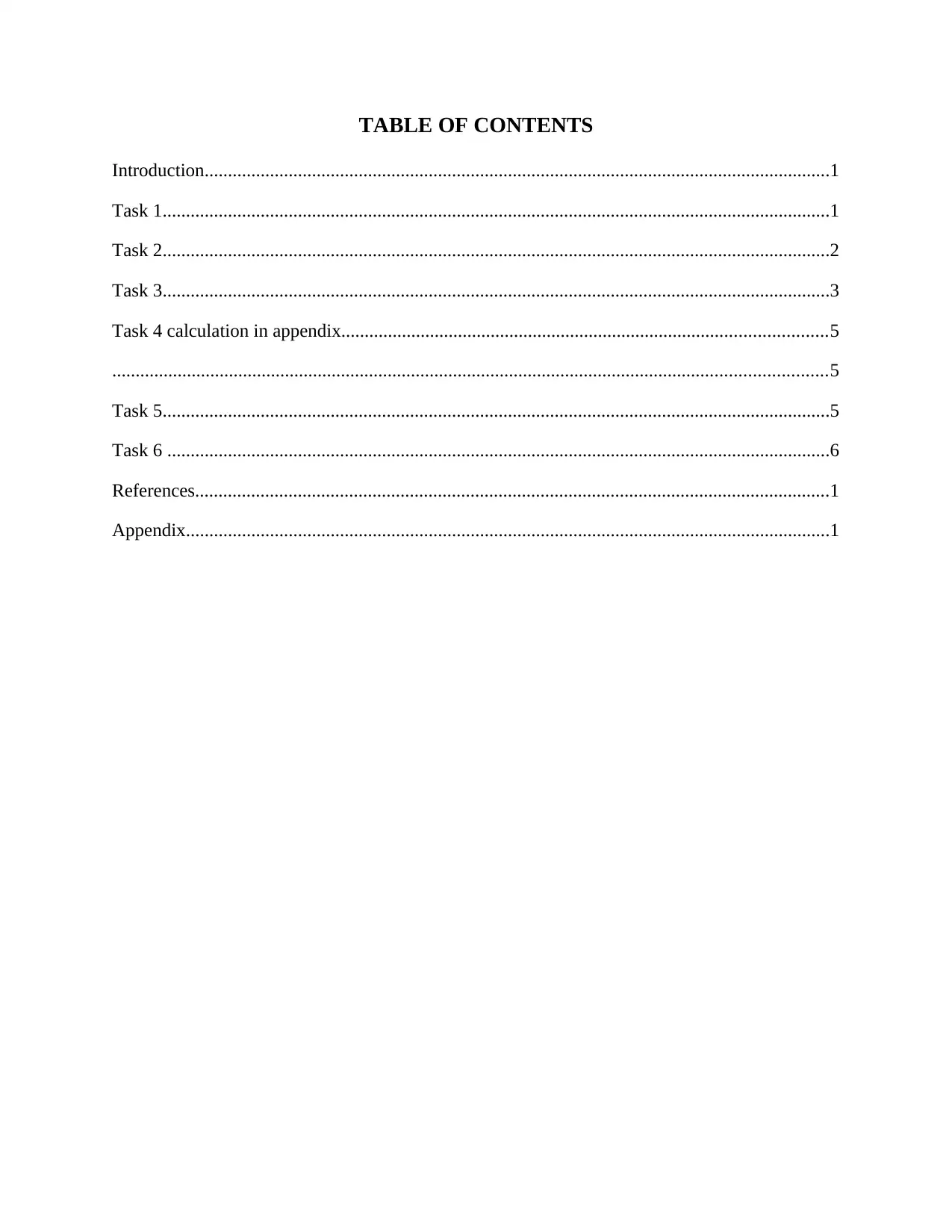
TABLE OF CONTENTS
Introduction......................................................................................................................................1
Task 1...............................................................................................................................................1
Task 2...............................................................................................................................................2
Task 3...............................................................................................................................................3
Task 4 calculation in appendix........................................................................................................5
.........................................................................................................................................................5
Task 5...............................................................................................................................................5
Task 6 ..............................................................................................................................................6
References........................................................................................................................................1
Appendix..........................................................................................................................................1
Introduction......................................................................................................................................1
Task 1...............................................................................................................................................1
Task 2...............................................................................................................................................2
Task 3...............................................................................................................................................3
Task 4 calculation in appendix........................................................................................................5
.........................................................................................................................................................5
Task 5...............................................................................................................................................5
Task 6 ..............................................................................................................................................6
References........................................................................................................................................1
Appendix..........................................................................................................................................1

Introduction
Financial information produced from the financial statements is of great importance for
the company. It helps in taking many crucial monetary decision related to the business. The
purpose of this report is to analyse the financial performance of Vodafone PLC on the basis of
ratio calculation and annual statements.
Task 1
The financial statements reflects the information about the results of operations, financial
position and cash flows within the business. Companies makes decisions related to allocation of
resources by using that information (Abraham, Deo and Irvine 2008). Every statement has its
own objective. These can be defined as follows:
Balance Sheet – This statement is a snapshot of the company’s business at the end of the
financial year. It includes all the assets and liabilities within the business. The purpose of
the balance sheet is to state the current financial position of the company in terms of
liquidity, funding, efficiency, debt etc.
Cash flow statement – This document shows the inflows and outflows of the cash during
the reporting financial period (Statement of Cash Flows, 2000). The purpose of the cash
flow statement is to reflect the nature of cash receipts and disbursements in various
categories.
Income statement – This document shows all the items related to income and expenses
within the business. The purpose is to show the ability of the company to generate profits.
It discloses the volume of sales and the nature of various types of expenses. It is also
capable of analysing the trends related to the company’s operations.
Terminology
Debit and credit – Under the double entry bookkeeping system, debits and credits are the
entries made in the account ledgers. It records the changes in the values which generates
from business transactions (Ball, Jayaraman and Shivakumar, 2012). It is to be noted that
source destination for the event is credited and destination account for the event is
debited.
1
Financial information produced from the financial statements is of great importance for
the company. It helps in taking many crucial monetary decision related to the business. The
purpose of this report is to analyse the financial performance of Vodafone PLC on the basis of
ratio calculation and annual statements.
Task 1
The financial statements reflects the information about the results of operations, financial
position and cash flows within the business. Companies makes decisions related to allocation of
resources by using that information (Abraham, Deo and Irvine 2008). Every statement has its
own objective. These can be defined as follows:
Balance Sheet – This statement is a snapshot of the company’s business at the end of the
financial year. It includes all the assets and liabilities within the business. The purpose of
the balance sheet is to state the current financial position of the company in terms of
liquidity, funding, efficiency, debt etc.
Cash flow statement – This document shows the inflows and outflows of the cash during
the reporting financial period (Statement of Cash Flows, 2000). The purpose of the cash
flow statement is to reflect the nature of cash receipts and disbursements in various
categories.
Income statement – This document shows all the items related to income and expenses
within the business. The purpose is to show the ability of the company to generate profits.
It discloses the volume of sales and the nature of various types of expenses. It is also
capable of analysing the trends related to the company’s operations.
Terminology
Debit and credit – Under the double entry bookkeeping system, debits and credits are the
entries made in the account ledgers. It records the changes in the values which generates
from business transactions (Ball, Jayaraman and Shivakumar, 2012). It is to be noted that
source destination for the event is credited and destination account for the event is
debited.
1
⊘ This is a preview!⊘
Do you want full access?
Subscribe today to unlock all pages.

Trusted by 1+ million students worldwide
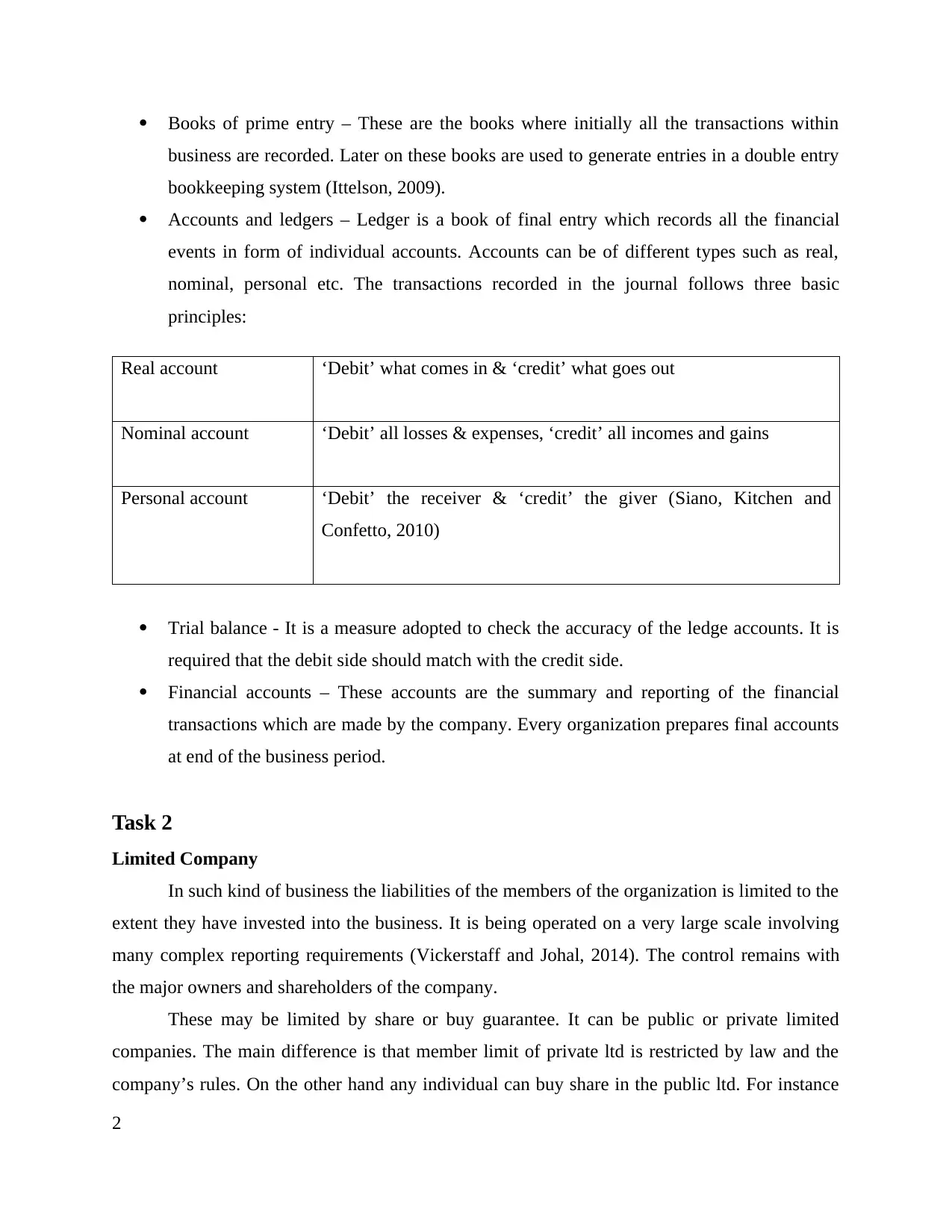
Books of prime entry – These are the books where initially all the transactions within
business are recorded. Later on these books are used to generate entries in a double entry
bookkeeping system (Ittelson, 2009).
Accounts and ledgers – Ledger is a book of final entry which records all the financial
events in form of individual accounts. Accounts can be of different types such as real,
nominal, personal etc. The transactions recorded in the journal follows three basic
principles:
Real account ‘Debit’ what comes in & ‘credit’ what goes out
Nominal account ‘Debit’ all losses & expenses, ‘credit’ all incomes and gains
Personal account ‘Debit’ the receiver & ‘credit’ the giver (Siano, Kitchen and
Confetto, 2010)
Trial balance - It is a measure adopted to check the accuracy of the ledge accounts. It is
required that the debit side should match with the credit side.
Financial accounts – These accounts are the summary and reporting of the financial
transactions which are made by the company. Every organization prepares final accounts
at end of the business period.
Task 2
Limited Company
In such kind of business the liabilities of the members of the organization is limited to the
extent they have invested into the business. It is being operated on a very large scale involving
many complex reporting requirements (Vickerstaff and Johal, 2014). The control remains with
the major owners and shareholders of the company.
These may be limited by share or buy guarantee. It can be public or private limited
companies. The main difference is that member limit of private ltd is restricted by law and the
company’s rules. On the other hand any individual can buy share in the public ltd. For instance
2
business are recorded. Later on these books are used to generate entries in a double entry
bookkeeping system (Ittelson, 2009).
Accounts and ledgers – Ledger is a book of final entry which records all the financial
events in form of individual accounts. Accounts can be of different types such as real,
nominal, personal etc. The transactions recorded in the journal follows three basic
principles:
Real account ‘Debit’ what comes in & ‘credit’ what goes out
Nominal account ‘Debit’ all losses & expenses, ‘credit’ all incomes and gains
Personal account ‘Debit’ the receiver & ‘credit’ the giver (Siano, Kitchen and
Confetto, 2010)
Trial balance - It is a measure adopted to check the accuracy of the ledge accounts. It is
required that the debit side should match with the credit side.
Financial accounts – These accounts are the summary and reporting of the financial
transactions which are made by the company. Every organization prepares final accounts
at end of the business period.
Task 2
Limited Company
In such kind of business the liabilities of the members of the organization is limited to the
extent they have invested into the business. It is being operated on a very large scale involving
many complex reporting requirements (Vickerstaff and Johal, 2014). The control remains with
the major owners and shareholders of the company.
These may be limited by share or buy guarantee. It can be public or private limited
companies. The main difference is that member limit of private ltd is restricted by law and the
company’s rules. On the other hand any individual can buy share in the public ltd. For instance
2
Paraphrase This Document
Need a fresh take? Get an instant paraphrase of this document with our AI Paraphraser

Vodafone is a public ltd organization headquartered in London, UK. The brand is listed on the
London Stock Exchange and is a member of the FTSE 100 index (Vodafone. 2015). The control
and management remains with the Board of Directors and major shareholder of the organization.
It is mandatory for Vodafone to produce all the three financial statements according to the
guidelines of IFRS and GAPE
Sole Trader
It is a very simplest form of business structure and it relatively involves very low cost for
set up. As a sole trader the owner of the business holds the responsibility for all the legal aspects.
He retains complete control on the assets and relevant financial decisions. There are very few
reporting requirements (Zoan, 2014). Very high amount of flexibility is there in adopting any
kind of change or innovation. The size of the business is low however there are unlimited
liabilities which means all the personal assets are at risk in case if things go wrong. The
preparation of the financial statements depends upon the willingness of the owner
Partnership
It is a kind of arrangement were parties known as the partners agrees to come together to
do a particular business. These partners could be individuals, companies, entities, schools etc. the
partners are liable for the debts and obligations of the company. The ratio for sharing of profits
and losses is decided in an agreed ratio. For that purpose a partnership deed has been established
between the parties (Ball, Jayaraman and Shivakumar, 2012). Under such business along with
the three financial statements, individual partner’s capital accounts are also prepared.
Task 3
Ratio Analysis
Current Ratio – This ratio shows the short term obligations of the business. It can be
interpreted that company has able to maintain a current ratio around less than 1. This
reflects that company has maintained a conservative approach to the working capital
management.
Quick ratio – It shows the extent of cash and other current assets that are readily
convertible into cash as compared to short term obligations of the business (Maynard,
2013). The ratio is lower than the industry average and this suggests that Vodafone is
taking too much risk by not maintaining a suitable safeguard of liquid resources.
3
London Stock Exchange and is a member of the FTSE 100 index (Vodafone. 2015). The control
and management remains with the Board of Directors and major shareholder of the organization.
It is mandatory for Vodafone to produce all the three financial statements according to the
guidelines of IFRS and GAPE
Sole Trader
It is a very simplest form of business structure and it relatively involves very low cost for
set up. As a sole trader the owner of the business holds the responsibility for all the legal aspects.
He retains complete control on the assets and relevant financial decisions. There are very few
reporting requirements (Zoan, 2014). Very high amount of flexibility is there in adopting any
kind of change or innovation. The size of the business is low however there are unlimited
liabilities which means all the personal assets are at risk in case if things go wrong. The
preparation of the financial statements depends upon the willingness of the owner
Partnership
It is a kind of arrangement were parties known as the partners agrees to come together to
do a particular business. These partners could be individuals, companies, entities, schools etc. the
partners are liable for the debts and obligations of the company. The ratio for sharing of profits
and losses is decided in an agreed ratio. For that purpose a partnership deed has been established
between the parties (Ball, Jayaraman and Shivakumar, 2012). Under such business along with
the three financial statements, individual partner’s capital accounts are also prepared.
Task 3
Ratio Analysis
Current Ratio – This ratio shows the short term obligations of the business. It can be
interpreted that company has able to maintain a current ratio around less than 1. This
reflects that company has maintained a conservative approach to the working capital
management.
Quick ratio – It shows the extent of cash and other current assets that are readily
convertible into cash as compared to short term obligations of the business (Maynard,
2013). The ratio is lower than the industry average and this suggests that Vodafone is
taking too much risk by not maintaining a suitable safeguard of liquid resources.
3
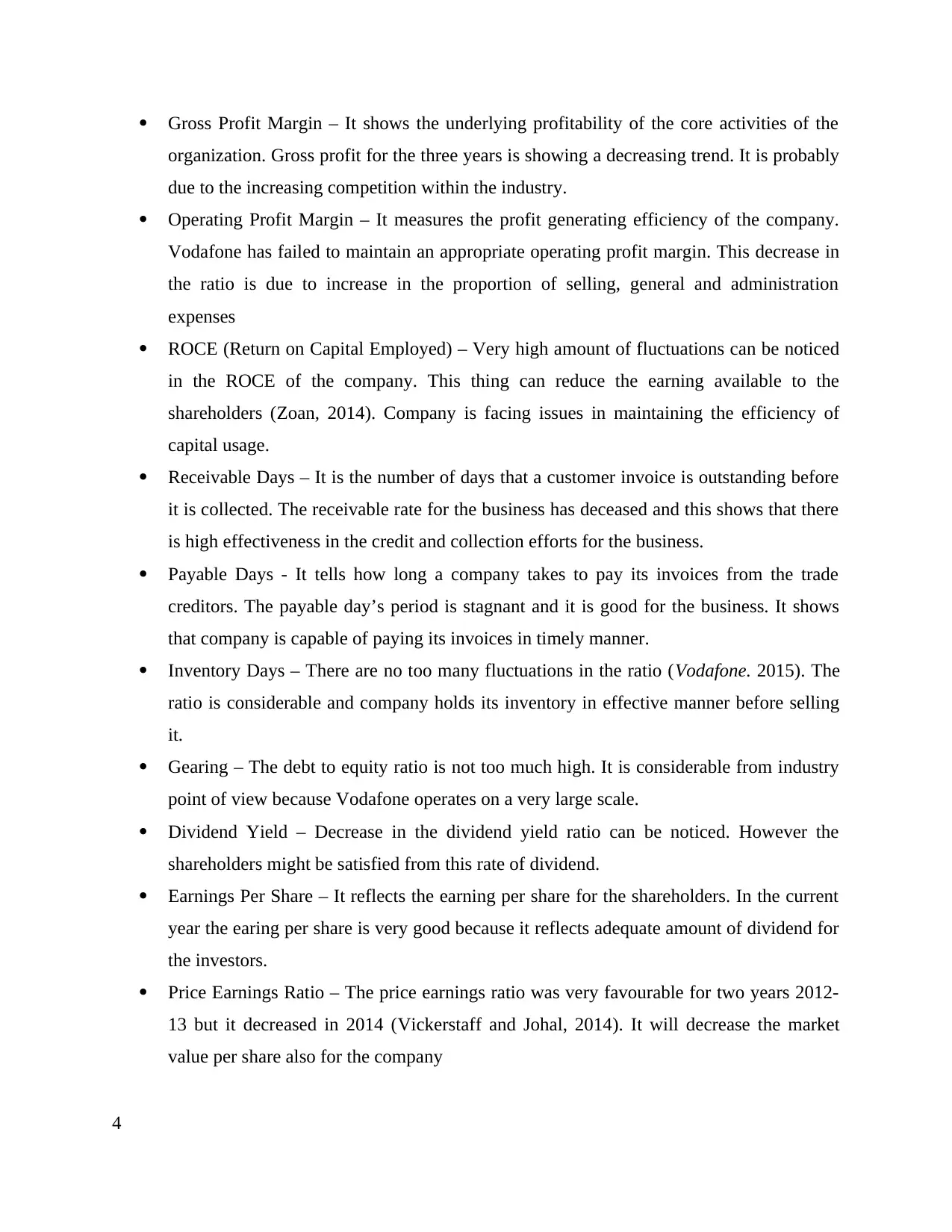
Gross Profit Margin – It shows the underlying profitability of the core activities of the
organization. Gross profit for the three years is showing a decreasing trend. It is probably
due to the increasing competition within the industry.
Operating Profit Margin – It measures the profit generating efficiency of the company.
Vodafone has failed to maintain an appropriate operating profit margin. This decrease in
the ratio is due to increase in the proportion of selling, general and administration
expenses
ROCE (Return on Capital Employed) – Very high amount of fluctuations can be noticed
in the ROCE of the company. This thing can reduce the earning available to the
shareholders (Zoan, 2014). Company is facing issues in maintaining the efficiency of
capital usage.
Receivable Days – It is the number of days that a customer invoice is outstanding before
it is collected. The receivable rate for the business has deceased and this shows that there
is high effectiveness in the credit and collection efforts for the business.
Payable Days - It tells how long a company takes to pay its invoices from the trade
creditors. The payable day’s period is stagnant and it is good for the business. It shows
that company is capable of paying its invoices in timely manner.
Inventory Days – There are no too many fluctuations in the ratio (Vodafone. 2015). The
ratio is considerable and company holds its inventory in effective manner before selling
it.
Gearing – The debt to equity ratio is not too much high. It is considerable from industry
point of view because Vodafone operates on a very large scale.
Dividend Yield – Decrease in the dividend yield ratio can be noticed. However the
shareholders might be satisfied from this rate of dividend.
Earnings Per Share – It reflects the earning per share for the shareholders. In the current
year the earing per share is very good because it reflects adequate amount of dividend for
the investors.
Price Earnings Ratio – The price earnings ratio was very favourable for two years 2012-
13 but it decreased in 2014 (Vickerstaff and Johal, 2014). It will decrease the market
value per share also for the company
4
organization. Gross profit for the three years is showing a decreasing trend. It is probably
due to the increasing competition within the industry.
Operating Profit Margin – It measures the profit generating efficiency of the company.
Vodafone has failed to maintain an appropriate operating profit margin. This decrease in
the ratio is due to increase in the proportion of selling, general and administration
expenses
ROCE (Return on Capital Employed) – Very high amount of fluctuations can be noticed
in the ROCE of the company. This thing can reduce the earning available to the
shareholders (Zoan, 2014). Company is facing issues in maintaining the efficiency of
capital usage.
Receivable Days – It is the number of days that a customer invoice is outstanding before
it is collected. The receivable rate for the business has deceased and this shows that there
is high effectiveness in the credit and collection efforts for the business.
Payable Days - It tells how long a company takes to pay its invoices from the trade
creditors. The payable day’s period is stagnant and it is good for the business. It shows
that company is capable of paying its invoices in timely manner.
Inventory Days – There are no too many fluctuations in the ratio (Vodafone. 2015). The
ratio is considerable and company holds its inventory in effective manner before selling
it.
Gearing – The debt to equity ratio is not too much high. It is considerable from industry
point of view because Vodafone operates on a very large scale.
Dividend Yield – Decrease in the dividend yield ratio can be noticed. However the
shareholders might be satisfied from this rate of dividend.
Earnings Per Share – It reflects the earning per share for the shareholders. In the current
year the earing per share is very good because it reflects adequate amount of dividend for
the investors.
Price Earnings Ratio – The price earnings ratio was very favourable for two years 2012-
13 but it decreased in 2014 (Vickerstaff and Johal, 2014). It will decrease the market
value per share also for the company
4
⊘ This is a preview!⊘
Do you want full access?
Subscribe today to unlock all pages.

Trusted by 1+ million students worldwide

Task 4 calculation in appendix
Task 5
Vodafone
The financial performance of Vodafone reflects the combination of good performance in
the emerging markets and challenging conditions in Europe. Company has succeeded in
offsetting competitive, regulatory and macroeconomic pressures in Europe. However the price
earning ratio of Vodafone is not showing impressive results. It shows what the market is willing
to pay for a stock based on its current earnings. This low performance can restrict the investors
from investing in the stocks of Vodafone.
5
Figure 1 Financial Position of Vodafone
(Source: Vodafone. Annual Reports 2014)
Task 5
Vodafone
The financial performance of Vodafone reflects the combination of good performance in
the emerging markets and challenging conditions in Europe. Company has succeeded in
offsetting competitive, regulatory and macroeconomic pressures in Europe. However the price
earning ratio of Vodafone is not showing impressive results. It shows what the market is willing
to pay for a stock based on its current earnings. This low performance can restrict the investors
from investing in the stocks of Vodafone.
5
Figure 1 Financial Position of Vodafone
(Source: Vodafone. Annual Reports 2014)
Paraphrase This Document
Need a fresh take? Get an instant paraphrase of this document with our AI Paraphraser
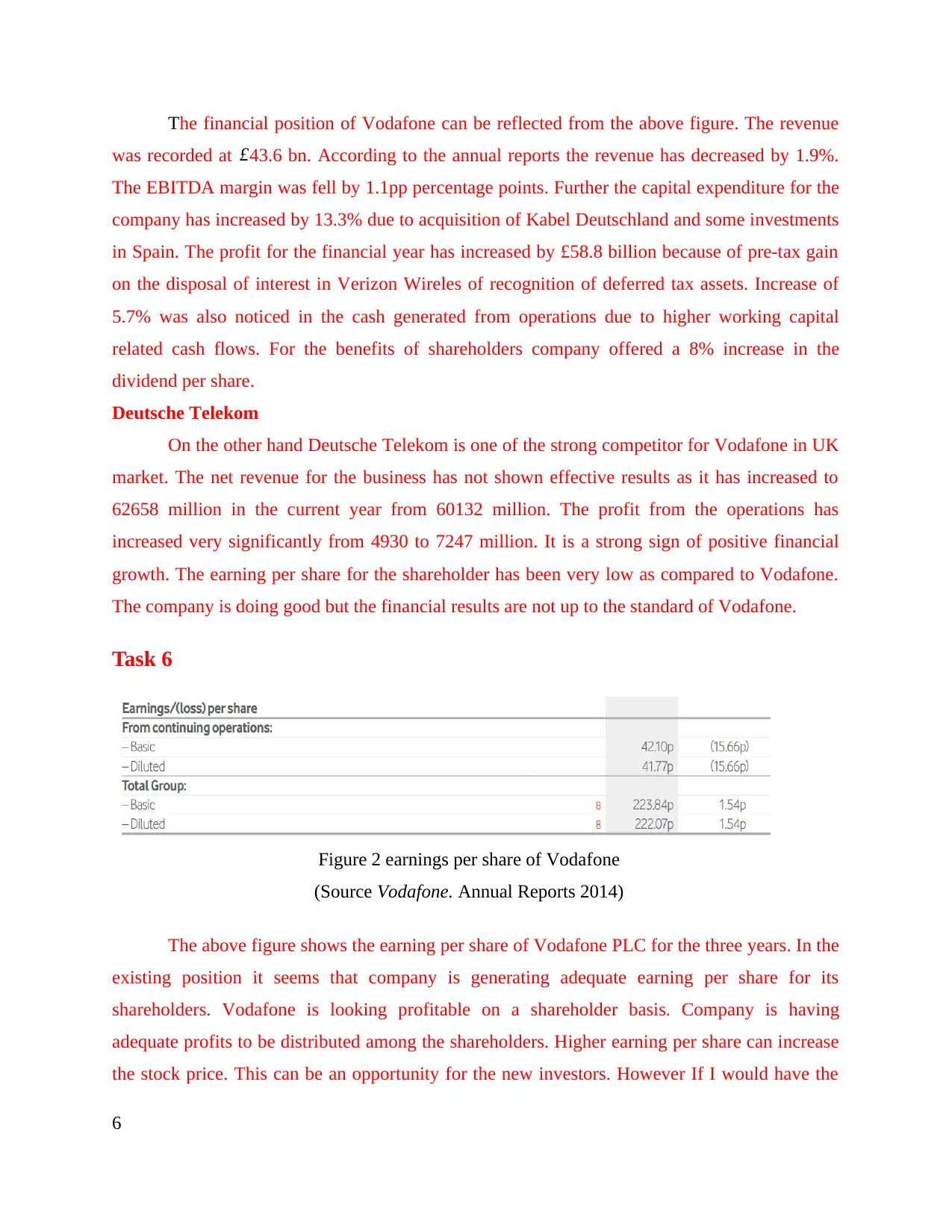
The financial position of Vodafone can be reflected from the above figure. The revenue
was recorded at £43.6 bn. According to the annual reports the revenue has decreased by 1.9%.
The EBITDA margin was fell by 1.1pp percentage points. Further the capital expenditure for the
company has increased by 13.3% due to acquisition of Kabel Deutschland and some investments
in Spain. The profit for the financial year has increased by £58.8 billion because of pre-tax gain
on the disposal of interest in Verizon Wireles of recognition of deferred tax assets. Increase of
5.7% was also noticed in the cash generated from operations due to higher working capital
related cash flows. For the benefits of shareholders company offered a 8% increase in the
dividend per share.
Deutsche Telekom
On the other hand Deutsche Telekom is one of the strong competitor for Vodafone in UK
market. The net revenue for the business has not shown effective results as it has increased to
62658 million in the current year from 60132 million. The profit from the operations has
increased very significantly from 4930 to 7247 million. It is a strong sign of positive financial
growth. The earning per share for the shareholder has been very low as compared to Vodafone.
The company is doing good but the financial results are not up to the standard of Vodafone.
Task 6
The above figure shows the earning per share of Vodafone PLC for the three years. In the
existing position it seems that company is generating adequate earning per share for its
shareholders. Vodafone is looking profitable on a shareholder basis. Company is having
adequate profits to be distributed among the shareholders. Higher earning per share can increase
the stock price. This can be an opportunity for the new investors. However If I would have the
6
Figure 2 earnings per share of Vodafone
(Source Vodafone. Annual Reports 2014)
was recorded at £43.6 bn. According to the annual reports the revenue has decreased by 1.9%.
The EBITDA margin was fell by 1.1pp percentage points. Further the capital expenditure for the
company has increased by 13.3% due to acquisition of Kabel Deutschland and some investments
in Spain. The profit for the financial year has increased by £58.8 billion because of pre-tax gain
on the disposal of interest in Verizon Wireles of recognition of deferred tax assets. Increase of
5.7% was also noticed in the cash generated from operations due to higher working capital
related cash flows. For the benefits of shareholders company offered a 8% increase in the
dividend per share.
Deutsche Telekom
On the other hand Deutsche Telekom is one of the strong competitor for Vodafone in UK
market. The net revenue for the business has not shown effective results as it has increased to
62658 million in the current year from 60132 million. The profit from the operations has
increased very significantly from 4930 to 7247 million. It is a strong sign of positive financial
growth. The earning per share for the shareholder has been very low as compared to Vodafone.
The company is doing good but the financial results are not up to the standard of Vodafone.
Task 6
The above figure shows the earning per share of Vodafone PLC for the three years. In the
existing position it seems that company is generating adequate earning per share for its
shareholders. Vodafone is looking profitable on a shareholder basis. Company is having
adequate profits to be distributed among the shareholders. Higher earning per share can increase
the stock price. This can be an opportunity for the new investors. However If I would have the
6
Figure 2 earnings per share of Vodafone
(Source Vodafone. Annual Reports 2014)
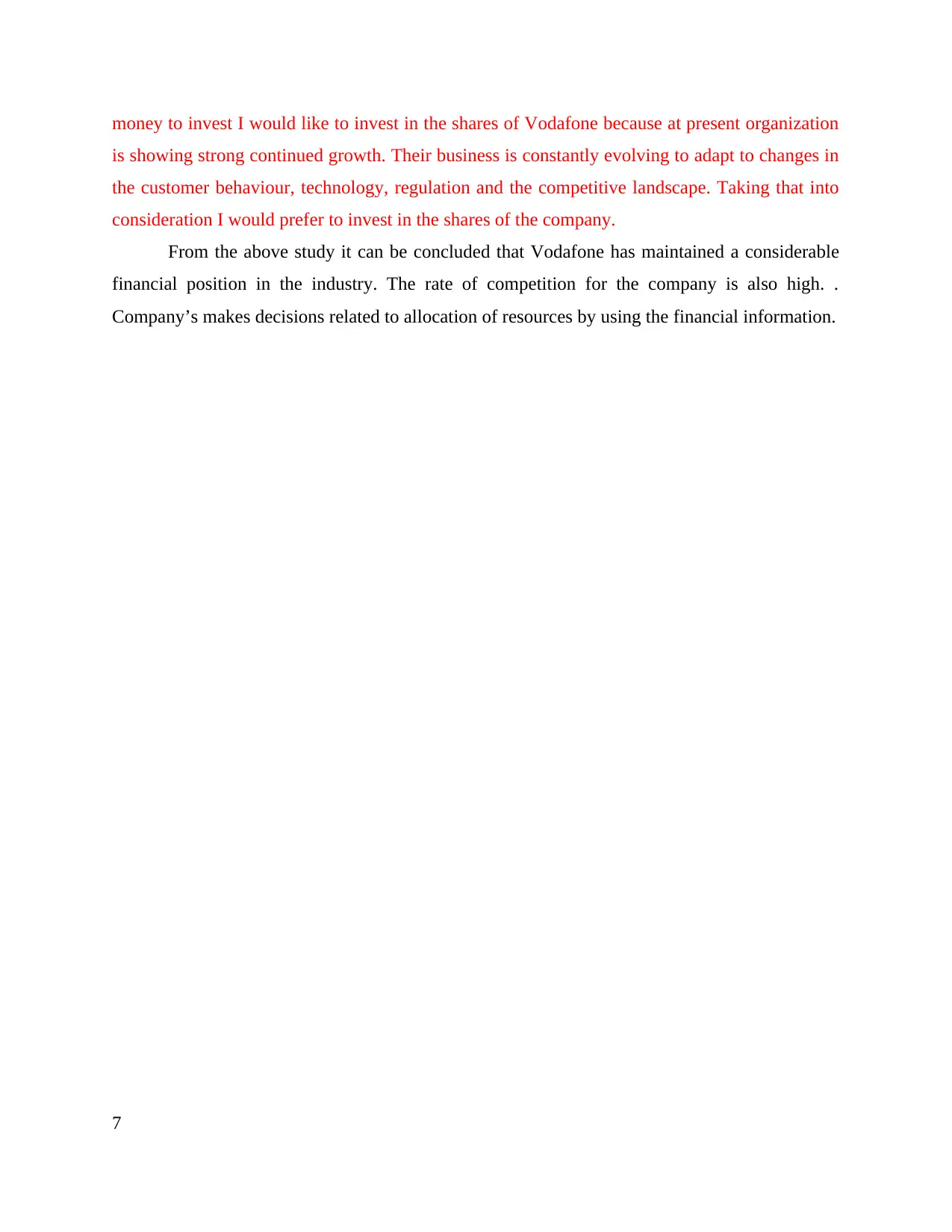
money to invest I would like to invest in the shares of Vodafone because at present organization
is showing strong continued growth. Their business is constantly evolving to adapt to changes in
the customer behaviour, technology, regulation and the competitive landscape. Taking that into
consideration I would prefer to invest in the shares of the company.
From the above study it can be concluded that Vodafone has maintained a considerable
financial position in the industry. The rate of competition for the company is also high. .
Company’s makes decisions related to allocation of resources by using the financial information.
7
is showing strong continued growth. Their business is constantly evolving to adapt to changes in
the customer behaviour, technology, regulation and the competitive landscape. Taking that into
consideration I would prefer to invest in the shares of the company.
From the above study it can be concluded that Vodafone has maintained a considerable
financial position in the industry. The rate of competition for the company is also high. .
Company’s makes decisions related to allocation of resources by using the financial information.
7
⊘ This is a preview!⊘
Do you want full access?
Subscribe today to unlock all pages.

Trusted by 1+ million students worldwide
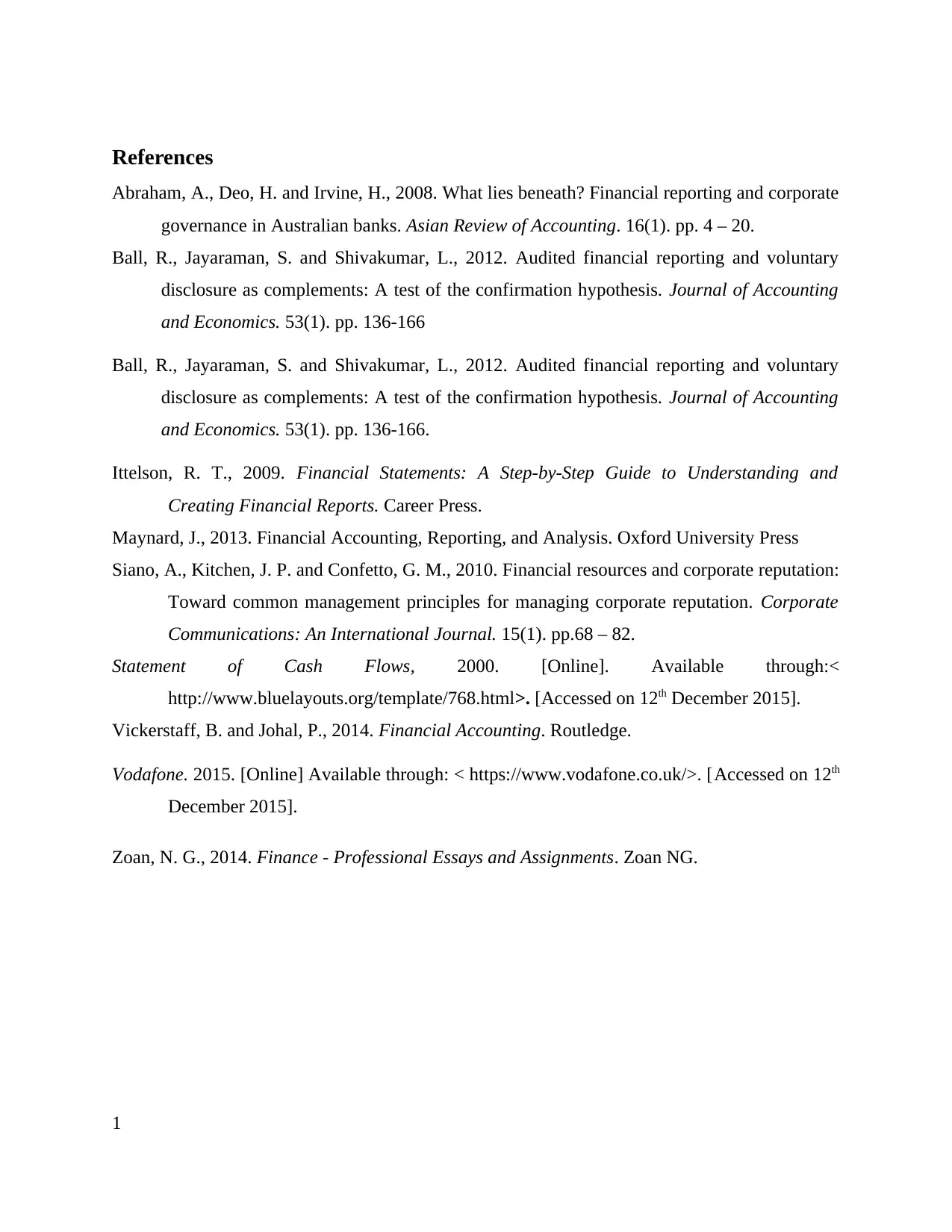
References
Abraham, A., Deo, H. and Irvine, H., 2008. What lies beneath? Financial reporting and corporate
governance in Australian banks. Asian Review of Accounting. 16(1). pp. 4 – 20.
Ball, R., Jayaraman, S. and Shivakumar, L., 2012. Audited financial reporting and voluntary
disclosure as complements: A test of the confirmation hypothesis. Journal of Accounting
and Economics. 53(1). pp. 136-166
Ball, R., Jayaraman, S. and Shivakumar, L., 2012. Audited financial reporting and voluntary
disclosure as complements: A test of the confirmation hypothesis. Journal of Accounting
and Economics. 53(1). pp. 136-166.
Ittelson, R. T., 2009. Financial Statements: A Step-by-Step Guide to Understanding and
Creating Financial Reports. Career Press.
Maynard, J., 2013. Financial Accounting, Reporting, and Analysis. Oxford University Press
Siano, A., Kitchen, J. P. and Confetto, G. M., 2010. Financial resources and corporate reputation:
Toward common management principles for managing corporate reputation. Corporate
Communications: An International Journal. 15(1). pp.68 – 82.
Statement of Cash Flows, 2000. [Online]. Available through:<
http://www.bluelayouts.org/template/768.html>. [Accessed on 12th December 2015].
Vickerstaff, B. and Johal, P., 2014. Financial Accounting. Routledge.
Vodafone. 2015. [Online] Available through: < https://www.vodafone.co.uk/>. [Accessed on 12th
December 2015].
Zoan, N. G., 2014. Finance - Professional Essays and Assignments. Zoan NG.
1
Abraham, A., Deo, H. and Irvine, H., 2008. What lies beneath? Financial reporting and corporate
governance in Australian banks. Asian Review of Accounting. 16(1). pp. 4 – 20.
Ball, R., Jayaraman, S. and Shivakumar, L., 2012. Audited financial reporting and voluntary
disclosure as complements: A test of the confirmation hypothesis. Journal of Accounting
and Economics. 53(1). pp. 136-166
Ball, R., Jayaraman, S. and Shivakumar, L., 2012. Audited financial reporting and voluntary
disclosure as complements: A test of the confirmation hypothesis. Journal of Accounting
and Economics. 53(1). pp. 136-166.
Ittelson, R. T., 2009. Financial Statements: A Step-by-Step Guide to Understanding and
Creating Financial Reports. Career Press.
Maynard, J., 2013. Financial Accounting, Reporting, and Analysis. Oxford University Press
Siano, A., Kitchen, J. P. and Confetto, G. M., 2010. Financial resources and corporate reputation:
Toward common management principles for managing corporate reputation. Corporate
Communications: An International Journal. 15(1). pp.68 – 82.
Statement of Cash Flows, 2000. [Online]. Available through:<
http://www.bluelayouts.org/template/768.html>. [Accessed on 12th December 2015].
Vickerstaff, B. and Johal, P., 2014. Financial Accounting. Routledge.
Vodafone. 2015. [Online] Available through: < https://www.vodafone.co.uk/>. [Accessed on 12th
December 2015].
Zoan, N. G., 2014. Finance - Professional Essays and Assignments. Zoan NG.
1
Paraphrase This Document
Need a fresh take? Get an instant paraphrase of this document with our AI Paraphraser

Appendix
1 RATIO CALCULATION
Ratio Formula 2012 2013 2014
Current Ratio
Current Assets
Current Liabilities 0.83 0.74 0.99
Acid Test
Current Assets – Inventory
Current Liabilities
0.81 0.73 0.81
Gross Profit
Margin
Gross Profit x 100%
Sales Revenue
32.03 31.3 27.13
Operating
Profit Margin
Operating Profit x 100%
Sales Revenue
24.1 10.63 -10.20
ROCE (Return
on Capital
Employed)
Operating Profit x 100%
Total Equity + Non-
Current Liabilities
(Capital Employed)
6.84 1.35 56.07
Receivable
Days
Accounts Receivable x
365 = Days
Sales Revenue
5.17 3.97 4.71
Payable Days
Accounts Payable x 365 =
Days
Cost of Sales
51.95 52.97 59.03
1
1 RATIO CALCULATION
Ratio Formula 2012 2013 2014
Current Ratio
Current Assets
Current Liabilities 0.83 0.74 0.99
Acid Test
Current Assets – Inventory
Current Liabilities
0.81 0.73 0.81
Gross Profit
Margin
Gross Profit x 100%
Sales Revenue
32.03 31.3 27.13
Operating
Profit Margin
Operating Profit x 100%
Sales Revenue
24.1 10.63 -10.20
ROCE (Return
on Capital
Employed)
Operating Profit x 100%
Total Equity + Non-
Current Liabilities
(Capital Employed)
6.84 1.35 56.07
Receivable
Days
Accounts Receivable x
365 = Days
Sales Revenue
5.17 3.97 4.71
Payable Days
Accounts Payable x 365 =
Days
Cost of Sales
51.95 52.97 59.03
1

Inventory Days
Inventory x 365 = Days
Cost of Sales
61.67 65.18 62.72
Gearing Debt / Equity
0.37 0.41 0.30
Dividend Yield
Dividend Per Share x 100
= %
Market Price Per Share
2.38 1.79 1.93
Earnings Per
Share
Profit After Tax
Attributable to
Shareholders = (Pence)
Number of Shares Issued
2.50 0.16 22.21
Dividend
Cover
Profit After Tax
Attributable to
Shareholders = Times
Total Dividend Paid
64.8 - 24.6
Price Earnings
Ratio
Market Price Per Share
Earnings Per Share
12.54 13.27 6.061
2. FINANCIAL STATEMENTS OF VODAFONE
Income statement
For the year ended 31 March
Restated
2014 2013
£m £m
Revenue 38,346 38,041
Cost of sales (27,942) (26,567)
2
Inventory x 365 = Days
Cost of Sales
61.67 65.18 62.72
Gearing Debt / Equity
0.37 0.41 0.30
Dividend Yield
Dividend Per Share x 100
= %
Market Price Per Share
2.38 1.79 1.93
Earnings Per
Share
Profit After Tax
Attributable to
Shareholders = (Pence)
Number of Shares Issued
2.50 0.16 22.21
Dividend
Cover
Profit After Tax
Attributable to
Shareholders = Times
Total Dividend Paid
64.8 - 24.6
Price Earnings
Ratio
Market Price Per Share
Earnings Per Share
12.54 13.27 6.061
2. FINANCIAL STATEMENTS OF VODAFONE
Income statement
For the year ended 31 March
Restated
2014 2013
£m £m
Revenue 38,346 38,041
Cost of sales (27,942) (26,567)
2
⊘ This is a preview!⊘
Do you want full access?
Subscribe today to unlock all pages.

Trusted by 1+ million students worldwide
1 out of 22
Related Documents
Your All-in-One AI-Powered Toolkit for Academic Success.
+13062052269
info@desklib.com
Available 24*7 on WhatsApp / Email
![[object Object]](/_next/static/media/star-bottom.7253800d.svg)
Unlock your academic potential
Copyright © 2020–2025 A2Z Services. All Rights Reserved. Developed and managed by ZUCOL.





